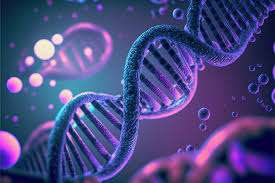New DNA Code Discovery Offers Insights into Gene Activity Regulation
Unveiling the “Spatial Grammar” of Gene Expression
A groundbreaking discovery has unveiled a novel code within DNA, now known as “spatial grammar,” which holds immense potential for transforming our comprehension of gene activity within the human genome. This pivotal revelation, the result of collaborative research conducted by teams at Washington State University (WSU) and the University of California, San Diego (UC San Diego), has been documented in the esteemed journal Nature. The identification of this concealed spatial grammar in DNA marks a significant leap forward, providing new insights into how genes are regulated and how genetic variations can impact gene expression. This discovery is poised to reshape our understanding of gene regulation mechanisms, particularly in relation to development and disease, by revealing previously unrecognized layers of complexity in how genes are turned on and off.

The implications of this finding extend far beyond basic genetic research. The concept of spatial grammar offers a more nuanced view of gene regulation, suggesting that the positioning and spacing of transcription factors—the proteins that control gene activation and repression—play a crucial role in determining gene activity. This newfound understanding could lead to revolutionary changes in how scientists study genetic variations and their effects on gene expression. By integrating the principles of spatial grammar into genetic research, we could gain deeper insights into the molecular underpinnings of genetic diseases and develop more effective approaches for diagnosis and treatment. The discovery not only challenges existing paradigms but also opens new avenues for exploring the complexities of the human genome.
The Role of Transcription Factors in Gene Regulation
At the core of this groundbreaking discovery lies a new understanding of transcription factors, the proteins that play a critical role in regulating which genes are activated or deactivated within the genome. Traditionally, transcription factors have been classified into two broad categories: activators, which enhance gene activity, and repressors, which inhibit it. However, the recent research conducted by teams at Washington State University (WSU) and the University of California, San Diego (UC San Diego) has unveiled a far more complex picture of these essential proteins.
- Complex Roles of Transcription Factors: The new research challenges the long-standing binary classification of transcription factors as merely activators or repressors. Sascha Duttke, an assistant professor at WSU’s School of Molecular Biosciences, highlighted that “true activators or repressors among transcription factors are surprisingly rare.” This revelation suggests that many transcription factors previously thought to function exclusively as activators can also act as repressors, depending on their context within the DNA.
- Implications for Gene Regulation: This nuanced understanding of transcription factors reveals that their roles in gene regulation are more dynamic and context-dependent than previously understood. The study’s findings imply that the traditional models of gene regulation, which often simplified transcription factors into fixed categories, may not fully capture the complexity of gene expression mechanisms.
- Revising Traditional Views: The discovery that most transcription factors can switch roles between activation and repression calls for a revision of current models in genetics. It underscores the need for a more sophisticated approach to studying how these proteins interact with the genome and influence gene activity.
Overall, this new insight into the multifaceted roles of transcription factors provides a more detailed and accurate picture of gene regulation. It has significant implications for how scientists study gene expression and could lead to new strategies for manipulating gene activity in research and therapeutic contexts.
The Complexity of Gene Activation: A Closer Look
This revelation became apparent when researchers noticed that removing an activator did not always result in a loss of gene activation, as was previously assumed. According to Bayley McDonald, a WSU graduate student involved in the study, “When we removed an activator, we expected to see a loss of activation. However, this only held true in about 50% to 60% of the cases, which indicated that our understanding was incomplete.”
Further investigation revealed that the function of many transcription factors is highly dependent on their spatial positioning within the DNA. The research demonstrated that the spacing between transcription factors and their position relative to the transcription start site of a gene play a crucial role in determining the level of gene activity.
For instance, transcription factors located upstream of the transcription start site may activate gene expression, while those positioned downstream could inhibit the same gene’s activity. This spatial arrangement, or “ambience,” as Duttke describes it, determines whether a transcription factor acts as an activator or repressor.
Implications of the Discovery for Genetic Research and Medicine
The implications of this discovery are profound. By integrating the concept of “spatial grammar” into the study of gene expression, scientists can gain a deeper understanding of how genetic mutations or variations influence gene activity. This newfound knowledge has the potential to significantly impact research in genetic diseases, developmental biology, and personalized medicine.

Christopher Benner, an associate professor at UC San Diego and co-author of the study, highlighted the far-reaching applications of this discovery: “The potential applications are vast. At the very least, it will change the way scientists study gene expression.” The insights gained from this research could pave the way for novel approaches to diagnosing and treating genetic disorders by allowing researchers to better understand the underlying mechanisms that drive gene expression.
Conclusion: A New Era in Gene Regulation Research
This breakthrough in understanding the spatial grammar of DNA signifies a monumental advancement in the field of genetics. By uncovering this previously hidden code, researchers have challenged long-standing assumptions about gene regulation and revealed a new layer of complexity within the intricate architecture of the human genome. The discovery of spatial grammar not only refines our understanding of how genes are turned on and off but also opens up novel pathways for investigating the regulation of gene expression. As scientists delve deeper into the complexities of this new code, it is expected to have a profound impact on future research and therapeutic strategies, potentially leading to groundbreaking developments in the treatment and management of genetic disorders. This advancement represents a pivotal shift in genetic research, promising to reshape our approach to studying and manipulating gene activity in profound ways.
More on
- https://www.micro2media.com/sustainability-initiatives-gain-momentum-ecoonline-survey-reveals-promising-trends-in-corporate-environmental-responsibility/
- https://www.micro2media.com/getting-teased-for-doing-it-for-the-planet-the-struggles-of-going-vegetarian-in-a-bbq-centric-world/
- https://www.technologynetworks.com/genomics/news/scientists-unveil-hidden-dna-code-that-controls-gene-activity-389968#:~:text=Summary,differently%20depending%20on%20their%20location.
- https://www.nih.gov/news-events/nih-research-matters/scientists-map-gene-regulating-networks-human-brain